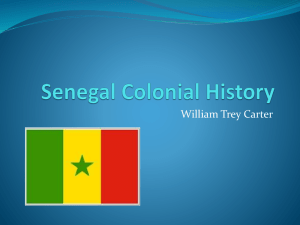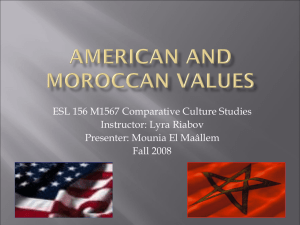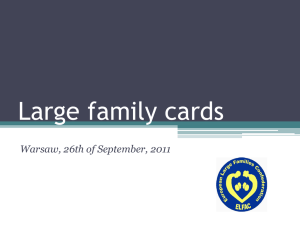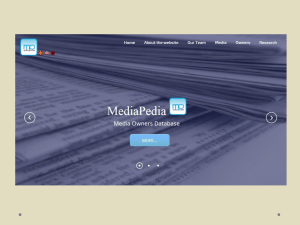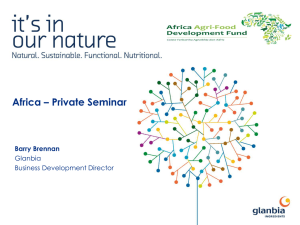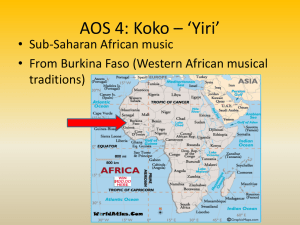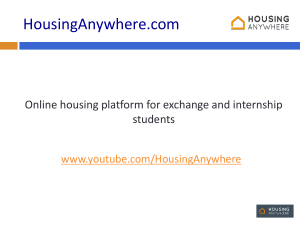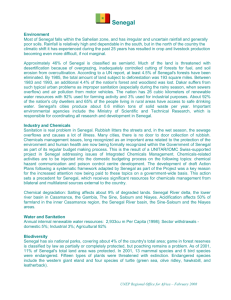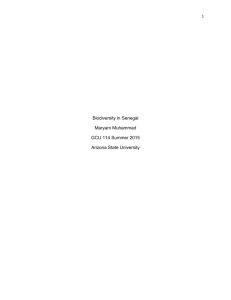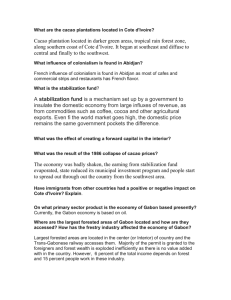Maghrebian Prospects in Africa: Morocco
advertisement
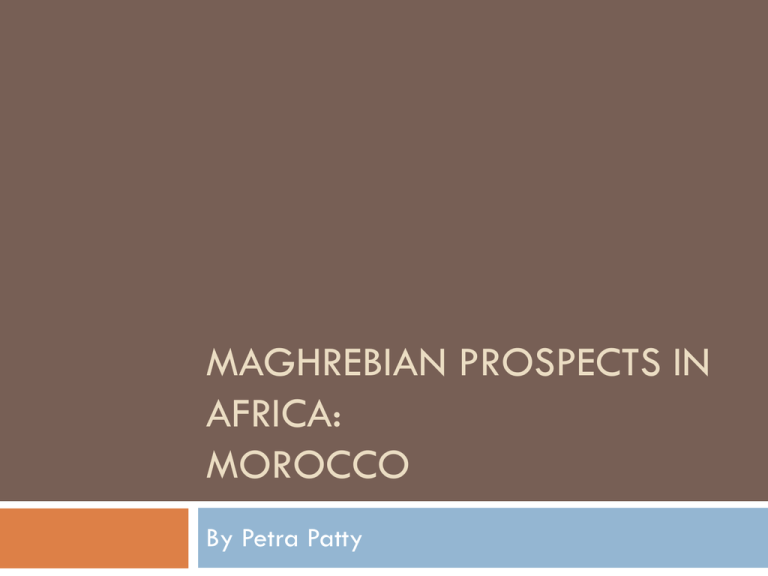
MAGHREBIAN PROSPECTS IN AFRICA: MOROCCO By Petra Patty Outline • • Introduction Politics: – • Foreign policy of Morocco towards Sub-saharan Africa Economics: – – – Agreements regulating relations Figures of trade Investments: • • • Banking Infrastructure Conclusions Foreign policy of Morocco towards Sub-saharan Africa • Two types of relations: – – • 1. Traditionally friendly: Senegal, Gabon, DR Congo, Guinee Equatorial, Mauritania, Ivory Coast 2. Ones made tense, mainly for political reasons to do with the Western Saharan conflict: Nigeria, South Africa, etc. 1980’s: – – – 1984, Morocco leaves the Organization of African Unity Developing relations with Angola (1985), Cape Verde (1987) 1986: Creation of Agence Marocaine de Coopération Internationale - AMCI Foreign policy of Morocco towards Sub-saharan Africa • 1990’s: – – • 150 different agreements by the middle of the decade Other efforts: Somalia 1992-93, visits: 1996, etc From 1999, King Mohammed VI. – – Repeated annual visits from 2001, including Gabon, Republic of Congo, Democratic Republic of Congo, Gambia 25 embassies in Africa, 6 new representations by the end of 2010 Foreign policy of Morocco towards Sub-saharan Africa • New direction of social cooperation: – 2006: Niger food crisis • – – – • 2004, visits to Bénin, Cameroon, Gabon, Niger and Senegal signing conventions 180-268 millions Euros of support to West-African and Central African countries Three sided cooperations – NEPAD (New Partnership for Africa’s Dvelopment) Strategy toward least developing countries: – – • Hospitalization, stock of drugs, pesticides, etc. 2000, European African Summit, Cairo 2003, Extraordinary Ministerial Conference for Least Developed Countries in Rabat Intensions of working together with organizations: – – – 2000, UEMOA (West African Economic and Monetary Union) 2001, joining COMESA (Common Market for Eastern and Southern Africa) 2002, Mano River Union Meeting in Rabat Agreements regulating relations • 2002, UEMOA (West African Economic and Monetary Union): – – • Trade and investment on industrial and agricultural products Not taken affect yet 2004, visits to Bénin, Cameroon, Gabon, Niger and Senegal: – – Conventions on non-double taxation, encouragement of investment, projects: expertise and funds Sea trade, mining, civil engineering, housing, water and education Agreements regulating relations • • • Strengthening relations, diversifying markets: bilateral economic and trade cooperations, classic or preferential, 17 countries Mixed inter-state commissions Private sector: – – – – Official support International forums Studies on trade prospects Organization for the support of export Current figures of trade Global sum of trade: 1990-1998: 300,6 million dollars on average per year 1998-2008: 529 million dollars Commercial trade: 101 million dollars deficit on average per year for the period of 1990-98 2008: 282,8 million dollar excess Current figures of trade • 2008, Moroccan export: – – – – • Export by zones: – – – – 4,46% to Africa (Main markets: Senegal, Equatorial Guinea and Ivory Coast, Congo, Nigeria, Ghana, Angola) 75,23% to EU 6,9% to Asia 2,72% to USA 27,2% to UEMOA 19,31% to CEMAC – Economic and Monetary Union of Central Africa 2% to SACU – Southern African Customs Union, 170% increase of trade between Morocco and Sub-saharan Africa: • • • 1998: 52,6 million dollars 2008: 1,4 billion dollars Versus Tunisia: 107 million dollars and Egypt: 320 million dollars Current figures of trade Main Sub-saharian suppliers of Morocco: Gabon, Congo, Central African Republic, Ivory Coast, Nigeria, Burkina Faso, Sénégal, South Africa Import by zones: 59,82% from SACU 17,5% from CEMAC 11,63% from UEMOA Composition of export, 1998-2008: Food products 45% Energy 3% Chemicals 12% Wood/Paper 5% Steel/Metals 3% Agriculture 1% Ores 2% Mechanic/electrical products 19% Textile/leather 9% Construction materials 1% 3% 1% 5% 9% 45% 19% 12% 2% 3% Source : Chelem, calcul DEPF 1% Composition of import, 1998-2008 Energy 49% Chemicals 1% Wood/paper 3% Food products 5% Ores 1% Mechanical/Electrical products 4% Steel/Metals 2% Agricultural products 35% 35% 49% 5% 2% Source : Chelem, calcul DEPF 4% 3% 1% 1% Current figures of trade Relations with countries who recognize the RASD (Sahrawi Arab Democratic Republic – or Western Sahara): Rebuilding relations for the past 10 years Moroccan economy more international Retreat of recognition South Africa: 210 million Euros in 2008 Nigeria: 60 million Euros in 2008 (720 million with Algeria) Investments • • 2008: amongst the top 20 investors in Africa Private sector: – • Taking expertise and know-how to the continent Strategic sectors: – – – – Banking Engineering Telecommunication Infrastructure (Royal Air Maroc) Banking: Attijariwafa Bank and BMCE • • First two moroccan groups on international markets. Attijariwafa Bank: – – – – • Present in Tunisia, Senegal (66,67% of Senegalo-tunisian Bank), Mali (51% of International Bank of Mali – 60 million Euros) GNP of the bank’s subsidiaries in Western Africa: 1,47 billion DH, Central Africa: 539 million DH 2009: took over 5 subsidiaries of Credit agricole: Congo, Ivory Coast, Cameroon, Gabon, Senegal, others in plan: Burkina, Togo, Niger, Equatorial Guinea 2010 April 29-30th, Casablanca BMCE – Banque Marocaine du Commerce Exterieur: – – – – – – Present in about 12 African countries Subsidiary in Senegal (BMCE Capital Dakar) loans 50 million Euros to the port of Dakar. 2007: acquisition of upto 35% of capital of the Bank of Africa (BOA) 2008: received 70 million euro support from the IFC (International Finance Cooperation) International subsidiaries: 8,5% of net turnover in 2008 – 74 million euros Outside BOA, operates in Congo-Brazzaville, Cameroon, Senegal and Tunisia Infrastructure: SOMAGEC, Groupe CCGT • SOMAGEC (Société Maghrébine de Génie Civil ): • • Leading builder of harbour and maritime infrastructure in Morocco, making a turnover of about 138 million Euros in 2008. Equatorial Guinea: – – – – – • • Subsidiary SOMAGEC GE 2 500 employees Built ports in Malabo, Kogo and Annobón Drinking water network in Bata In three years: 1,3 billion Euros 2006: invitation to apply for building the port of Dakar in Senegal Groupe CCGT (Consortium des Canalisation des Granulats et des Travaux): • • • Present in Guinea for 12 years, Sierra-Leone as well as Guinea-Bissau Guinea: 70 million DH, agricultural area of 724 ha Senegal: construction of a 230 km road Conclusion Africa: alternative market to the european Despite marked improvements in the past decade, only 5% of Morocco’s export goes to Africa Still alot of potential: Improved political stability Economic transparency Rise of purchasing power Exemplary behaviour

